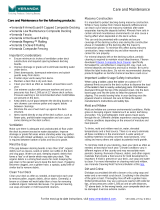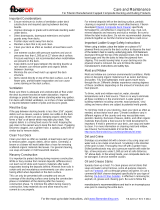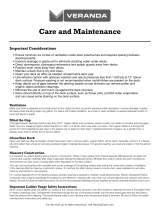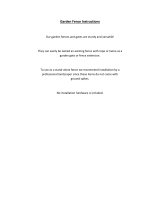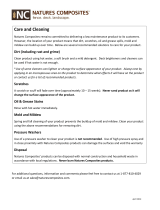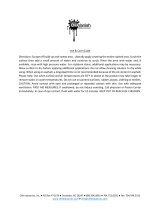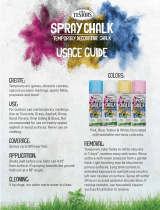
Cleaning your Composite Fence
Dirt and Grime
Dislodge accumulated dirt with a broom or by using soap and water and a non-metal scrub brush.
Scrubbing in the direction of the grain is best. Thoroughly rinse off with a garden hose. Skilled
professionals may use a pressure washer with wide fan tips, at low pressures, under 1,500 psi, and at
safe distances, 12" above surface. In the wrong hands, your composite fence can be damaged. Exercise
extreme caution.
Oil and Grease Stains
Speedy clean up is best. To clean grease and oil stains that soap and water cannot remove, some all
purpose cleaners, such as Fantastik, will cut through grease and grime, or use a commercial composite
cleaner designed specifically for this type of fencing. De-Solv-It Citrus Solution is effective in removing
tar, asphalt, oil, grease and chewing gum. Be sure to follow the manufacturer’s recommendations and
test in an inconspicuous area prior to cleaning the entire fence.
Mold and Mildew
Mold and mildew are common environmental conditions. Molds grow on decaying organic material such
as wood, leaf decay and pollen. Tiny and lightweight, mold spores travel easily through the air. Different
climates experience varying degrees of these conditions depending on the amount of moisture and heat
present.
To thrive, mold and mildew need air, water, elevated temperatures and a food source. There is no way
to eliminate all these conditions in the environment. A wide variety of building materials including
concrete, wood products, vinyl siding and many others are subject to potential mold growth.
To minimize mold on your fencing, clean your fence as often as needed, at least twice each year. Climate
conditions vary in different regions of the country and may necessitate more periodic cleaning. Removal
of leaves, debris, and other organic materials that provide a food source for mold development is
important. If mold is present on your fence, there are many commercial products available for cleaning
mold.
We recommend the following commercial cleaners. For best results, be sure to follow the
manufacturer’s instructions and use cleaners within their stated shelf life. Do not mix recommended
cleaning products together as harmful chemical reactions could occur. Never mix bleach and acids.
• Collier Manufacturing 30-Seconds® Outdoor Cleaner & 30-Seconds® Spray & Walk Away are heavy
duty, mildly alkaline chlorinated mold and mildew removers/ cleaners that are biodegradable once
rinsed into the soil, and have been tested to perform very well in removing mold & mildew, and
retarding its return.
• Composite Deck Cleaner & Enhancer by Expert Chemical Company is a heavy duty, mildly alkaline
chlorinated mold and mildew remover/ cleaner that is biodegradable once rinsed into the soil.
Fiberon tested with excellent results, a coating option for areas in the country with high mold prone
environments. Using the 30-day ASTM D3273 mold test, there was no mold growth after applying the



